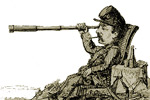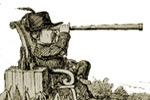
STOP #4
CULP'S HILL OBSERVATION TOWER |
This position was not a signal station. However, because of the increase in
timber growth on the battlefield, this tower offers the best view of the
signal stations on the field. Climb the observation tower and orient yourself
to the other signal sites on the battlefield. While you can't use your compass
due to the metal in the tower, most of the sites can be located by using the
round sighting device located in the center of the observation deck.
During the period of the Gettysburg Campaign, signal officers and soldiers
were trained in a number of ways. Many received little or no formal training
other than on-the-job. The Army's formal signal training was instituted in
August 1861, with the creation of the Signal Camp of Instruction at Red Hill,
near Georgetown, D.C. The camp served as the Army's primary center for
training signal soldiers. A description of the Signal Camp of Instruction is
in Appendix II.
Col. Myer established a signal drill whch was patterned after the manual of
arms then in use. These training drills were used at the Signal Camp of
Instruction as well as smaller unit sponsored schools and on the job training
within the signal parties. Myer wrote his manual in 1864 but the drills were
in common use prior to the manual being published. A Manual of Signals.is
lengthy and tends to be redundant, but it certainly does not want for detail.
The following excerpts from the chapter on signal instruction gives a flavor
of the style of training popular at the time.
Experience has shown that as, in the Manual of Arms, the soldier
must be continually drilled to maintain his full efficiency, so in the
practice of signalling, a drill, regular and habitual, is needed to fit
either officer or man for the duty in the first place, and to retain them
then with that skill which is needed in the moment of danger and of actual
war.
The instruction should commence with the study of the principles of
signalling, and the theories of their general use. The pupil should be well
grounded in this study before practice is entered upon. He should then be
required to commit to memory certain signal alphabets to be used; and these
are to be so thoroughly memorized that no signal combination will require
thought to determine its meaning. The General Service Flag and Homographic
Codes are to be committed in this manner. To this follows practice in the
recitation-room with the "wand," a slender rod about eighteen inches long, -
the class reading messages signalled by the instructor in the alphabets
learned, rapid movements of the wand; or practising in couples, transmitting
messages with the wand to each other during the hours set aside for
study,-until each is able to read messages of what ever character signalled
with the greatest rapidity of motion that can be given. And in this portion
of the course should be included practice with codes of different numbers of
elements, and signalled by different modes of position or of motion, until
the pupil is well accustomed to rapidly read and make the signals. He is
practised also in rapidly repeating signals as they are made to him, both
according to the plans given for returning signals to the sending station
...
[Albert J. Myer, A Manual of Sicinals,
New York, D. Van Nostrand, 1866,
pp. 220-221.]
Memoirs of Captain Gustavus S. Danna, U.S. Army Signal Corps
On Reporting at H.Hd [Hilton Head] I was obliged to take a
solemn oath never to have in my possession anything that our code might be
written on, never to tell it to anyone, not even our flagmen unless by
proper a thority. Then I was furnished a kit & glasses and sent to
Beaufort for instruction with the understanding that if not ready for duty
in 30 days I would be expected to return to my regt. there were four of us 2nd
Lts. in the same detail. Each of us had selected 4 enlisted men from our
regts who were also detailed by the same order.
The code written on a sheet of paper was handed me by Lt [Townsend L.]
Hatfield with instructions to commit it to memory and then destroy the
paper. It was terrible hard at first but about midnight I had the alphabet
and then spelled books full till most morning and lighted my pipe with the
paper the code was on just at streak of dawn.
Then we had the men to learn how to make the motions. It looked simple to
wave a flag but it takes considerable practice even after you know how to
make the motions to prevent wrapping the flag about the pole. The officers
stationed at Beaufort were [Charles F.] Cross, [Townsend L.] Hatfield,
[Franklin E.] Town & [W.H.] Hammer and they gladly let us work the
station as soon as we could without making mistakes for it gave them more
time for fun ...
[Captain G. S. Dana,
"The Recollections of a Signal
Officer",
edited by Lester L. Swift,,Civil War History,
State Universitv of
Iowa, Vol IX, No I, March 1963, p. 38.]
Return to your automobile and drive to STOP 5.
Proceed down the hill on SLOCUM AVENUE and stop beside the
road across from the equestrian statue of MAJ. GEN. SLOCUM. Walk across the
road to the grassy area surrounding the statue.
| 



